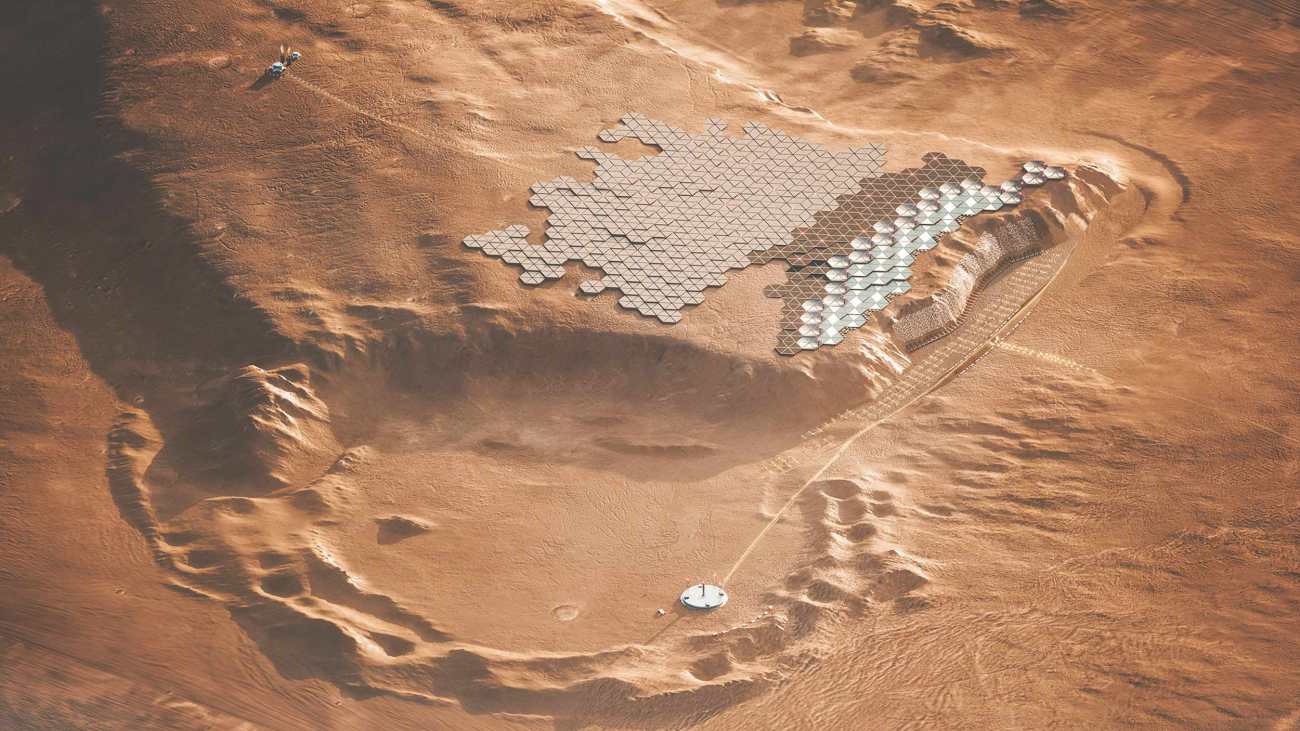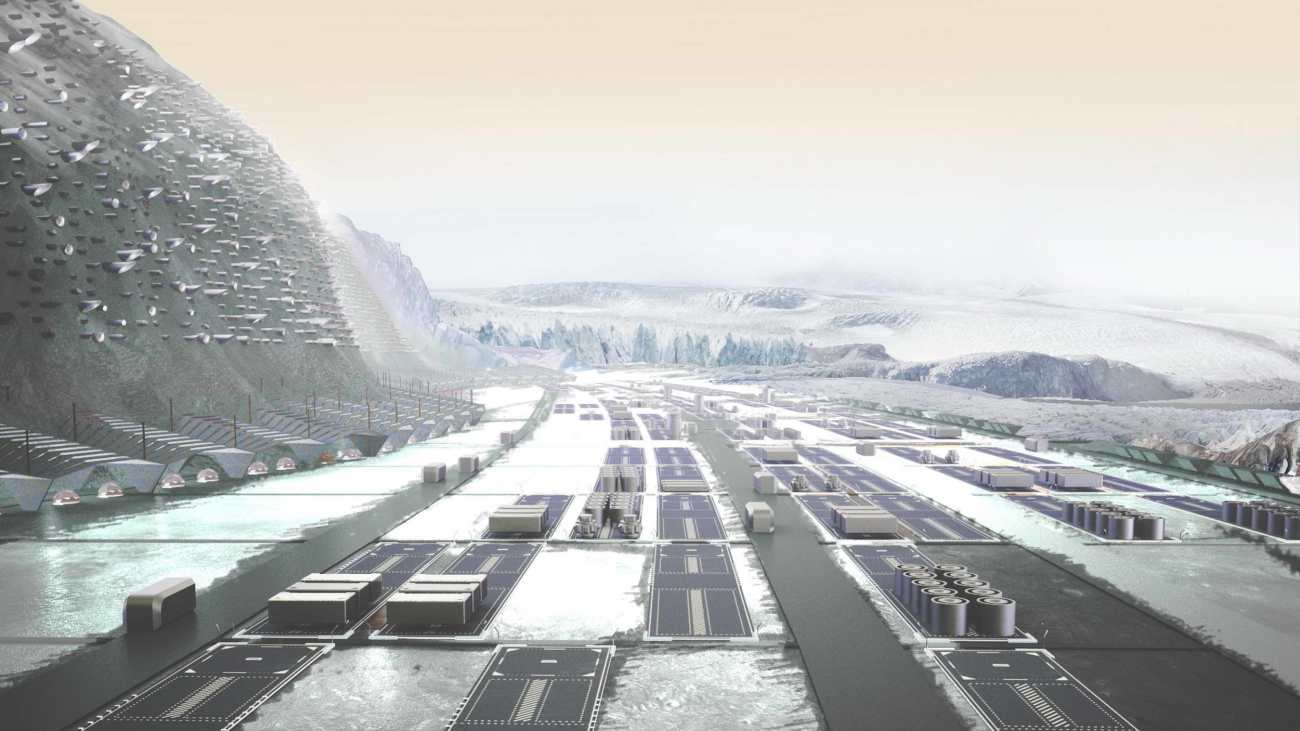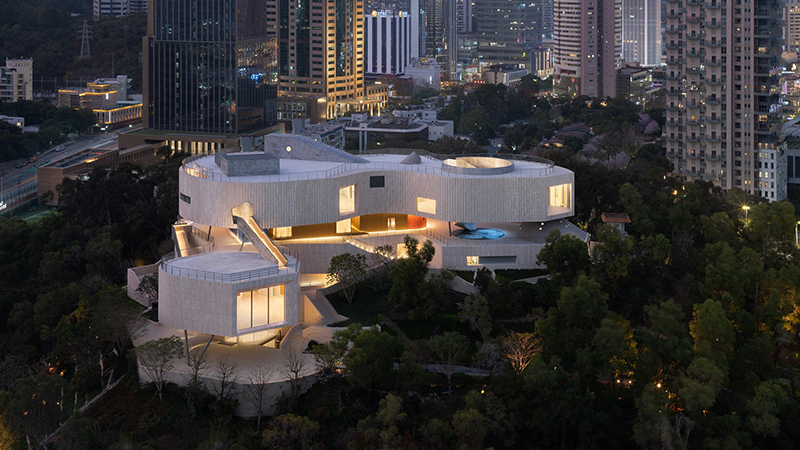ABIBOO工作室设想了在火星上打造一座自给自足的可持续发展城市,这座城市可以容纳100万人类。 该项目名为 "女娲",是火星协会组织的竞赛的详尽科学工作的一部分,并由SONet全面开发,SONet网络是一个由天体物理学家Guillem Anglada领导的国际科学家和学者团队,团队曾领导发现了外行星Proxima-B。
ABIBOO Studio (www.abiboo.com) has led the architectural design of a self-sufficient and sustainable city on Mars that can house one million humans. The project is called Nüwa and is part of an exhaustive scientific work for a competition organized by The Mars Society, and fully developed by the SONet network (www.Sonet-hub.com), an international team of scientists and academics, headed by the astrophysicist Guillem Anglada, who led the discovery of exoplanet Proxima-B.
▼项目视频 Video
考虑到大气条件,负责建筑设计的团队ABIBOO工作室选择了火星上的悬崖边来建造一座垂直城市。设计和建筑系统是基于地球的恶劣条件而产生的。"如果我们像在地球上一样建造这样的建筑,建筑会因为压力而坍塌。火星上的太阳辐射和伽马辐射迫使我们建造不直接暴露在天空中的空间。"ABIBOO工作室的创始人Alfredo Muñoz说。
Considering the atmospheric conditions, ABIBOO Studio, the team heading the architectural design, chose the side of a cliff on Mars to build a vertical city. The design and construction systems are a result of the planet's harsh conditions. "If we were to construct the buildings as on Earth, the buildings would tend to explode from the pressure. The solar and gamma radiation on Mars forced us to build spaces that are not directly exposed to the sky", says Alfredo Muñoz, founder of ABIBOO Studio, an international architectural and urban design firm specialized in large-scale projects.
该设计包括五个城市,以女娲市为首都,每座城市可容纳20万至25万人口。除女娲市外,其余城市也遵循同样的城市战略,如位于火星北极的阿巴洛斯城,以充分利用冰雪的通道,或位于太阳系最广阔的峡谷的马里纳利斯城。该解决方案是一种灵活的、可扩展的模式,可以很容易地适用于许多其他火星区域。
The design includes five cities, with Nüwa as their capital. Each city accommodates between 200,000 and 250,000 people. Aside from Nüwa, the rest of the cities follow the same urban strategy, such as Abalos City, located in the North Pole to leverage the access to ice, or Marineris City, located in the most extensive canyon of the solar system. The solution is a flexible and scalable model that could be easily applicable in many other Martian surface areas.
在这些火星城市的设计中,建筑师们面临着重新定义结构的挑战,以保证适合人类和其他形式的有机生命。建筑师与学者和SONet的其他成员合作,提出了一些解决方案,以创建保护居民免受火星上的辐射的结构,确保间接获得阳光,防止来自陨石的潜在影响,并解决建筑物内部和外部的大气压差。城市配置还必须考虑生命支持系统,如食物、空气和水的生产。
In these Martian cities' design, the architects faced defining structures that would guarantee a habitat suitable for humans and other forms of organic life. Working with academics and other members of SONet, the architects came up with solutions to create structures that protect inhabitants from the radiation on Mars, ensure indirect access to sunlight, protect from potential impact from meteorites, and solve the atmospheric pressure difference between the inside and the outside of the buildings. The urban configuration also had to consider the life support systems, such as food, air, and water production.
模块化结构
女娲城位于Tempe Mensa的火星悬崖斜坡上,有丰富的水源。陡峭的地形提供了一个可以建立一个插入岩石中的垂直城市的机会,也能防止暴露在阳光下的辐射。
Modular structure
The city of Nüwa is on the slope of one of the Martian cliffs with abundant water access, located at Tempe Mensa. A steep terrain offers the opportunity to create a vertical city inserted into the rock, protected from radiation and exposed to indirect sunlight.
建筑是在悬崖的岩石中挖掘出来的。这些建筑是在开凿隧道后实施的,因此是模块化的。建筑空间包括居住和工作空间,由一个三维的隧道网络连接在一起。这些模块呈管状,直径10米,长60米,共两层。有三个不同的居住模块和三个工作模块,根据需要重新组合模块,提供了一个高度灵活和可扩展的机会。通过赋予这种标准化的设计,确保了可扩展性,降低了复杂性、成本和施工进度。
The "Macro-buildings" are excavations inside the rock of the cliff. These constructions, implemented after tunneling, are modular and include residential and work activities, linked together by a three-dimensional network of tunnels. The modules have a tubular shape of 10 meters in diameter and 60 meters long, with two floors. There are three different residential and three work modules, providing a highly flexible and scalable opportunity by recombining the modules as needed. By giving this standardization, the design ensures scalability and reduces complexity, costs, and construction schedules.
所有模块都包括绿色区域和城市花园,以及专门用于艺术的空间,以及被称为"雪穹顶"的冷凝区有助于散热和清洁空气。城市花园是小型社区公园,里面有动物和水系,旨在提供有利于身体健康的空间。
All modules include green areas and urban gardens, spaces dedicated to art, and condensation areas, called "Snow-domes," that help dissipate heat and clean the air. The urban gardens are small community parks with animals and bodies of water designed to provide physical well-being.
为了建立与地球的情感联系,设计团队在女娲城里加入了巨大的、人工创造的自然空间。它们被命名为"绿色穹顶",有两种类型:一种是允许人类存在并充当公园的,另一种是在纯火星氛围的环境中加入实验性的植物。
To create an emotional linkage with Earth, the design team has included vast, artificially created natural spaces in Nüwa. They are named "Green-Domes," and there are two types: those that allow human presence and act as parks, and those that include experimental vegetation in an environment with a purely Martian atmosphere.
垂直城市
悬崖上的建筑由高速电梯系统连接,类似于地球上的摩天大楼。这些高速电梯系统用独立的升降系统连接着所有空间,还连接着悬崖底部和顶部,中间还设有"天梯"站。
A vertical city
The "Macro-buildings" on the cliff are connected by high-speed elevator systems, similar to skyscrapers on Earth. This infrastructure also connects the bottom of the cliff with the top and has intermediate stops at the "sky-lobbies", that connect the "Macro-buildings" with a separate elevating system.
悬崖的最高点称为Mesa。这片广阔的平原包含了专门用于制造、食品生产和能源生产的基础设施。
The highest point of the cliff is the Mesa. This vast plain contains the infrastructure dedicated to manufacturing, food production, and energy generation.
在悬崖的脚下有许多大型的亭子,供居民社交使用,这些亭子被设计成半透明,可以欣赏到火星的风景。这些穹顶由大型的顶棚保护而不受外部辐射,悬崖开凿出来的材料被覆盖在这种顶棚上,保护其免受辐射。同时,这种策略也保证了即使是大规模的回收利用。在山谷中,还有一些特定的建筑,用于安置医院、学校和大学、体育和文化活动、购物区以及与航天飞机沟通的火车站。用从挖掘中提取的额外材料建造的人工山作为城市的视觉框架。它包含了辅助能源系统、储藏室、探测器和城市内部卡车的停车场。
At the foot of the cliff, large pavilions have been located for social interaction in the Valley. These pavilions have been designed with translucent skin to offer views of the landscapes of Mars. These domes are protected from external radiation by large overflying canopies. The material from the cliff's excavation is dumped on top of such roofs, protecting from radiation. At the same time, this strategy ensures recyclability even at a large-scale. In the Valley, there are also specific structures to house hospitals, schools and universities, sports and cultural activities, shopping areas, and train stations that communicate with the space shuttle. An artificial mountain created with additional material extracted from the excavations acts as a visual frame for the city. It contains auxiliary energy systems, storage, and parking for rovers and intra-city trucks.
维持生命的基础设施
除了生活、工作、教育和促进社会交往的建筑外,火星上的人类定居点还需要建筑来满足空气、水和食物生产的基本功能。在女娲城及其附近的城市,所有的建筑结构都包含安全方面的设施,以调节内部大气压力,并为紧急情况提供避难区。一些公共空间为市民提供了防火通道和避难所,直到救援单位在紧急情况下到达。
Life-Support infrastructure
In addition to buildings to live, work, educate, and facilitate social interactions, a human settlement on Mars also requires structures to fulfill the essential functions of air, water, and food production. In Nüwa and its adjacent cities, all the architectural constructions include additional safety aspects to regulate the internal atmospheric pressure and offer refuge zones for emergency cases. Several common spaces act as firebreaks and shelter for citizens until rescue units' arrival in case of an emergency.
每个建筑的入口处都放置了空气淋浴器,作为健康保护措施进行清洁和消毒。人工智能(AI)也将在女娲的建筑标准中发挥重要作用,以帮助保持最佳条件并将风险降至最低。
Air showers have been placed at each "Macro-building" entrance to clean and sterilize as health protection measures. Artificial Intelligence (AI) will also play an essential role in Nüwa's building standards to help maintain optimal conditions and minimize risks.
农作物将在富含二氧化碳的农业模块建筑中生长,而且这些设施中的操作任务将实现自动化。为了提高农作物的效率,SONET的天体生物学专家团队设计了一种水耕系统,与其他基于地面作物的方法相比,它需要更少的水和空间。藻类、细胞肉和用于废物处理的细菌的生产也在这一区域完成。
Crops would be grown in agricultural modules with a CO2-enriched environment, which will not be breathable for humans. As a result, the operational tasks in these facilities will be automated. To increase the crops' efficiency, the team of experts in astrobiology of SONet opted for a hydroponic system that requires less water and space than other methods based on above-ground crops. The production of algae, cellular-meat, and bacteria for waste processing are also completed in this sector.
动物和昆虫的养殖区已经设在谷地,靠近城市公共区域,因为它们需要类似人类的生活氛围。悬崖内的"绿色穹顶"和城市花园也是一些动物的栖息地。但团队留给动物的空间是比较小的,因为畜牧业所需的能量很高,在火星的条件下是不可行或不可持续的,因此人们在火星饮食中的肉类是极其稀少的。
Farming areas for animals and insects have been located at the Valley, close to communal city areas, as they need a human-like atmosphere to live. The "Green Domes" and the urban gardens inside the cliff are also habitats for some animals. In any case, the space destined for animals is relatively small. The low consumption of meat predicted in the Martian diet is due to the high energy required for livestock farming, which would not be viable or sustainable in the red planet's conditions.
交通
城市内的交通是通过高速电梯沿悬崖垂直方向进行的。此外,公共汽车和轻轨系统提供城市内部的横向交通。一个火车站网络连接到位于附近火山口的太空机场,城市内的所有交通都是通过电动车在加压空间内进行的。不同火星城市之间的交通由在铺装道路上行驶的公共汽车或火车来解决。
Transportation
Mobility within the city is carried out in a vertical direction along the cliff through high-speed elevators. Additionally, a system of buses and light-trains provides intra-city horizontal transport. A network of train stations connects to the space airport, located at a nearby crater. All transportation within the city is carried out within pressurized spaces through electric vehicles. The mobility between different Martian cities is solved by buses or trains that travel on paved roads.
女娲城和相邻城市成倍地容纳人口。经过最初短时间的资本投入和来自地球的供应,火星上的这种城市发展以其手段和可持续的方式保持和发展。建造城市所需的所有材料都是在火星上通过加工碳和其他矿物获得的。SONet的科学家和ABIBOO工作室的建筑师分析了女娲所需的材料,以及如何以可持续的方式利用当地资源制造和获得所需系统。
Nüwa and adjacent cities exponentially accommodate their population. After an initial short period of capital investment and supply from Earth, this urban development on Mars maintains and grows by its means and sustainable manner. All the materials required for constructing the city are obtained on Mars by processing Carbon and other minerals. The scientists at SONet and the architects at ABIBOO Studio analyzed the materials needed for Nüwa and how to manufacture and obtain the required system with local resources in a sustainable manner.
项目源起
女娲城项目是来自世界各地的175个项目中的一个入围者,这些项目提交给了火星协会今年的2020年竞赛,火星协会是一个致力于促进人类探索和殖民火星的美国非营利组织。入围者在10月15日至18日举行的2020年年会上提交了自己的方案,伊隆马斯克(Space X)、乔治-怀特塞德(维珍银河)和吉姆布里登斯廷(NASA)等人也出席了会议。在几个月的工作中,ABIBOO工作室领导的建筑师团队从美国、西班牙、英国和阿根廷等世界各地远程工作,完成了这座火星上的城市开发。SONet网络包括来自天体物理学、建筑学、天体生物学、空间工程、天体地质学、心理学和化学等不同学科的专家。成员遍布三大洲。来自多学科领域的25个以上的人努力使女娲成为一个实用、独特和可行的火星城市。
Origin of the project
Nüwa was a finalist among 175 projects from around the world submitted to this year's 2020 competition by The Mars Society, an American non-profit organization dedicated to promoting the human exploration and colonization of the planet Mars. The finalists presented their proposals at the 2020 annual convention held between 15 and 18 October, which also featured Elon Musk (Space X), George Whitesides (Virgin Galactic), and Jim Bridenstine (NASA), among others. The team of architects led by ABIBOO Studio worked remotely during the months of work to complete this city's development on Mars, from distant locations such as the United States, Spain, United Kingdom, and Argentina. The SONet network includes experts from disciplines as diverse as Astrophysics, Architecture, Astrobiology, Space Engineering, Astrogeology, Psychology, and Chemistry, among other fields. The members live across three continents. More than 25 people from multidisciplinary fields have worked to make Nüwa a functional, unique, and feasible city on Mars.
Project: Nüwa
Design Firm: ABIBOO Studio
Authors: Guillem Anglada-Escudé, Alfredo Muñoz Herrero, Miquel Sureda, Gisela Detrell, Ignasi Casanova, David Cullen, Miquel Banchs i Piqué, Gonzalo Rojas, Engeland Apostol, Sebastián Rodríguez, Verónica Florido, Philipp Hartlieb, Laia Ribas, Owen Hughes Pearce, David de la Torre.
Contributors: Jordi Miralda Escudé, Rafael Harillo Gomez-Pastrana, Lluis Soler, Paula Betriu, Uygar Atalay, Pau Cardona, Oscar Macia, Eric Fimbinger, Stephanie Hensley, Carlos Sierra, Elena Montero, Robert Myhill, Rory Beard.
Sponsors: ABIBOO Studio, CSIC, UPC, University of Stuttgart, Cranfield University, IEEC, Montan Universitat Loeben, University of Portsmouth.
Image credit: ABIBOO Studio / SONet
更新日期:2021-04-09 16:14:37
非常感谢 ABIBOO Studio 与 SONet 带来的精彩项目, 查阅更多Appreciations towards ABIBOO Studio and SONet for sharing wonderful work on hhlloo. Click to see more works!





























